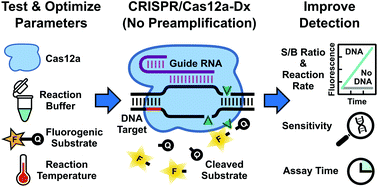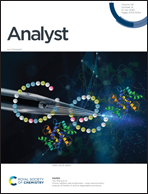Applying biosensor development concepts to improve preamplification-free CRISPR/Cas12a-Dx†
Abstract
Development of CRISPR/Cas-based in vitro diagnostic devices, or CRISPR/Cas-Dx, has become an intensely researched area. Among the different classes of CRISPR/Cas-Dx, the class based on the Cas12a enzyme (i.e., CRISPR/Cas12a-Dx or simply Cas12a-Dx), is predominantly employed for detecting DNA targets. Current research in Cas12a-Dx has focused on appending Cas12a-Dx to preamplification techniques or coupling Cas12a-Dx to different detection modalities, which has inevitably overshadowed the detection performance of Cas12a-Dx and overlooked its intrinsic detection capability without preamplification. We recognize that Cas12a-Dx, which relies on DNA-activated Cas12a to cleave single-stranded DNA, shares significant similarity with other nuclease-based DNA biosensors, whose performances can be influenced by parameters ranging from the reaction buffer to the reaction temperature. We are thus inspired to probe the limits of preamplification-free Cas12a-Dx by exploring and systematically evaluating several potential parameters that may impact its detection sensitivity and time. Using a previously reported fluorescence-based Cas12a-Dx as the test bed, we have identified that the Cas12a enzyme, the reaction buffer, the substrate label, the substrate concentration, and the reaction temperature can be optimized to significantly improve the signal-to-background ratio and the reaction rate of Cas12a-Dx. Based on these findings, we have improved the limit of detection (LOD) of the Cas12a-Dx to 100 fM, while reduced the time-to-positive to <46 min, representing the most sensitive LOD without preamplification and the fastest time-to-positive for this LOD to date. More broadly, our work provides a roadmap for further advancing Cas12a-Dx and perhaps other classes of CRISPR/Cas-Dx.



 Please wait while we load your content...
Please wait while we load your content...